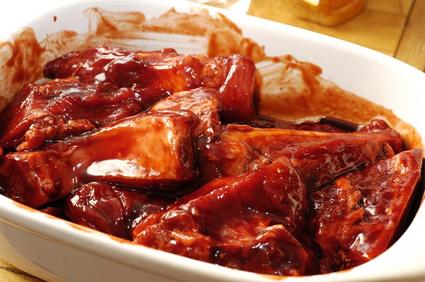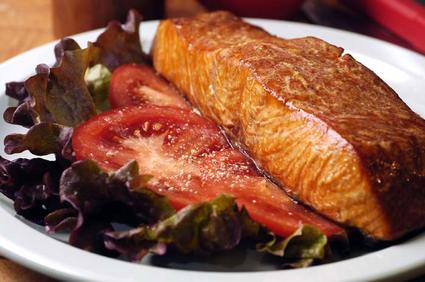
I’ve been monkeying around Barbara’s Tigers & Straberries for quite a few months, reading posts, checking out recipes and leaving odd comments when possible. I stumbled upon this recipe for Char Siu last Thursday and knew it was for me. A quick jaunt to the Asian grocery and we were set, Meathead visits often and knew where everything was, thanks MH.
Are you ready?

Here are a list of the ingredients she used, please refer to Barbara’s recipe for the details.
Ingredients:
pork shoulder or butt
dark soy sauce
light soy sauce
honey
oyster sauce
shao Hsing wine
hoisin sauce
five spice powder
black pepper
red food coloring (optional)
Pretty straight forward, don’t you think? Since this is a marinade, you need to get this ready at least a day in advance. Barbara says a few hours to 24 and I say, no less than 24. There’s just no way the meat can take on the marinade in 2 hours, maybe if you vacuum marinade it, but I don’t have one of those rigs.
I know the recipe lists the red food coloring as optional, but I don’t believe it’s right without it. Check out that red!
All in all it was an easy deal. Remove the marinading meat and allow to warm up a bit. Get the smoker going and steady, about an hour or so. Make sure your smoky chips or chunks are going nicely, no puffs of white & brown smoke. Once the smoker is ready, install pork pieces in the cooler portion. See, the pieces aren’t all that large, not like 10 pound pork butt and will cook quite quickly. Mine only took 2 hours before they were fall to pieces perfect juicy smoky.
Depending on the size of your rig, you’ve probably got some room left over. I sure did and tossed on a little portion of fresh salmon for Mama, she likes the salmon.

No words are necessary here.
While I’m sure the oven version, 450 degrees for 20 minutes will produce a wonderful product, I’d like to think smoking the pork added a nice angle to the Asian flavors. If I was going to change anything, I would add some of that spicy & hot pepper sauce. You know the one, it has all the hot pepper flakes lolling about in it? I might also add some fresh garlic, smooshed very very very finely. Other than that, what you have here is a wonderful, easy to prepare marinade for pork. I will most certainly be using this again in the coming months.
Xo Xo

I don’t really understand the difference between light and dark soy sauce. Couldn’t you just use something sorta in the middle?
Oy, that food looks good. I wanted that salmon to have marinated in your goop, too!
Jumping in the answer your question, cookiecrumb:
Light soy sauce is just regular soy sauce.
Dark soy sauce has some sugar added–caramel, to be precise. It has a different flavor and thickness–and the two combined are what is required in the recipe.
If you had to go with one or the other, you could go with light and use more honey–and that is what I would do.
Dr. Biggles–we are getting a firebox for our grill so we can make this US/Chinese barbeque fusion come spring. Because it sounds just bloody delicious.
I can’t wait.
Now–next time, you have to make extra so you can make that lo mein I wrote about….;-)
Hey Cookie,
I have no idea what I’m doing, but my first response is no way. The dark stuff comes out like a syrupy deal and must lend a large amount of rich flavors that you simply cannot get in the lighter. I paid no more than a buck fifty per container, I say buy it all and try.
What’s next?
Biggles
Well, thank you both! Just yesterday I tasted the most boutique-y, perfect, candied soy sauce from Japan (so esoteric, the label was entirely in kanji). It was surely a “dark.”
You guys are cool.
xx
Dark soy sauce is sometimes sold as “Double” soy sauce or “Black” soy sauce.
But not as “thick” soy sauce–that is another type of soy sauce entirely. It comes in jars, and is very thick and dark with molasses–it is also quite sweet.
It is what is used to give restaurant fried rice its brown color–if you use regular soy sauce from bottles to make your fried rice brown, you will end up with rice that tastes like a salt lick. (And I realize as I write this–does anyone but a country girl like you even know what you mean by “salt lick?” I will assume folks will get it from context….)
I agree with the Dr.–soy sauces from the Asian market are so inexpensive–go ahead and get both and then have twice the fun things to play with when you aren’t making char siu.
For a quick and dirty on what to do with light and dark soy sauce–light is good with fish, shellfish, and chicken and some pork stir fries–particuarly when you are doing a good dish featuring lighter, more natural flavors and you want the soy sauce to just enhance them, not really add its own flavor.
Dark soy sauce, on the other hand is rich–it is good for braised dishes, and stir fries with beef or some cuts of pork (and some dishes with chicken, in fact–if you use a lot of garlic, ginger, chiles, onions and scallions, the dark soy sauce is a good one to use). It imparts a really nice reddish brown color to sauces.
I should probably post about how many versions of soy sauce live in my pantry sometime…and they all have their purposes.
Barbara: (Oops, hijacking Biggles’ thread) — I would love that.
I second the need for a soy sauce discussion. I didn’t know there existed more kinds than light and dark and I always thought those two were mostly interchangeable.
i, too, am intrigued by the soy sauce discussion. i only think in terms of regular and low sodium.
Hey Princess,
I wasn’t aware, but wasn’t surprised. The sauce isles at Ranch 99 in El Cerrito hold an awful lot of treasures, not to mention the noodles isles.
Biggles
You’ll also see them listed as “thin” soy sauce and “double black” soy sauce (Kow Loon brand).
I use the light or thin soy sauce generally (like over rice), and use the thick or double black soy sauce in marinades and sauces.
k.
Just a painful note on soy sauce, and other things with that caramel thing going (like colas, e.g.), they are apparently hell for creating kidney stones. Just heard this last week, so, if you’re prone, go for the light if at all possible.
On the Char Siu, the recipe I originally used called for “glucose” IIRC. It came in a little plastic tub, from the Asian market, at it was THE STICKIEST stuff I’ve ever seen. Forget Crazy Glue, but it was da bomb for getting the sweetness right, if you don’t mind fighting the sticky.
Hey B’gina,
FIGHT THE STICKY !!!
Aieee! Here’s the lowdown on soy sauce from a Chinese guy, (me):
Real soy sauce is a fermented product like beer, and the resulting types come from the same basic brew.
Light or thin soy sauce is younger. It is very salty and lighter in color, hence the name. It is used mostly as a seasoning and source of saltiness when cooking and eating. Think of it as flavored salt.
This is not to be confused with the modern LITE soy sauce, the lower sodium kind. This is basically a watered down blended version of light soy sauce, to reduce the overall sodium percent of the product.
Dark soy sauce is aged longer, and like balsamic vinegar, gets thicker and sweeter. It is not as salty as light soy sauce, and is used to add color, flavor and sweetness to marinades and dishes. It will darken the color in dishes quite a bit.
Caramel coloring and other artificial flavorants are added in cheaper brands to approximate the appearance, but not in true dark soy sauce.
Thick soy sauce is another animal altogether, that does have added sweeteners and color.
Then there are the flavored soy sauces, like shrimp or mushroom soy. Those are tasty too!
The stuff found on supermarket shelves can do in a pinch, but check their ingredients. It should be a fairly recognisable list, without chemical additives, otherwise it is not the real stuff. Also some “Americanized” brands are a blend of light and dark soy sauces and are kind of a “medium” of the two, not a salty or sweet as either.
Hey Calicook,
Thanks for stopping by, that was awesome.
I don’t trust my local mega marts. I make my way to the local Asian markets and buy sauces that have no english other than a title word or two. I figure then and only then I get something worf using.
Biggles
Roasted Pork Yakibuta
This morning when I was hanging around a local wet market, initially, I was looking for some roasted pork at the butcher to prepare a quick stir-fried vegetables. But, it was too late when the time I reached, the beautiful roasted pork was finished.
So…
My wife is allergic to oyster sauce but loves char sui what else could I substitute instead of that for her?